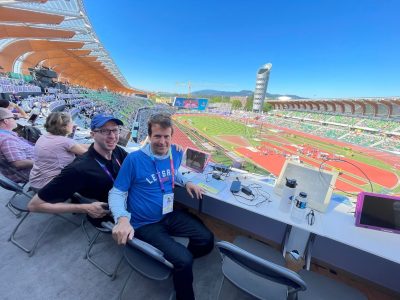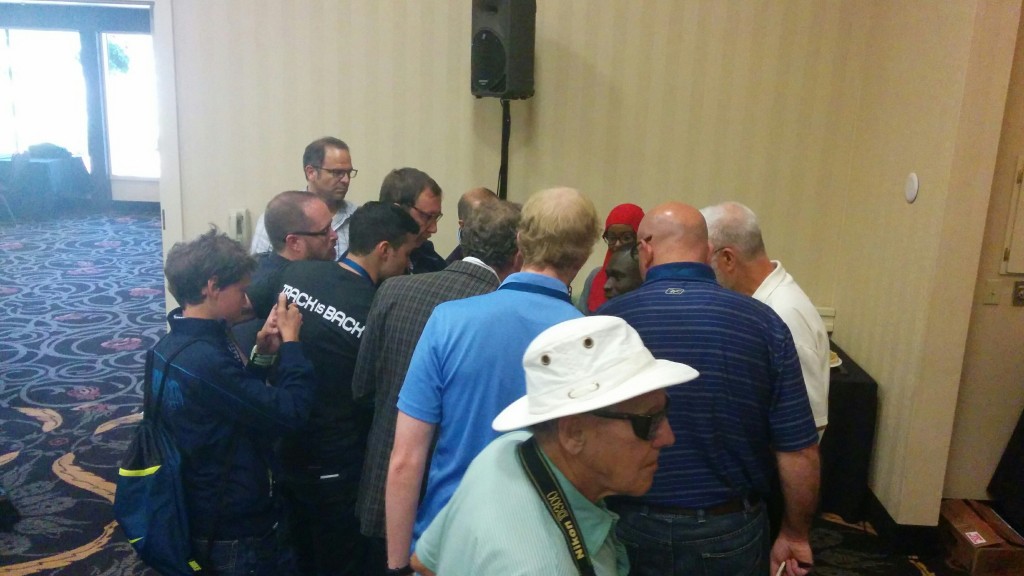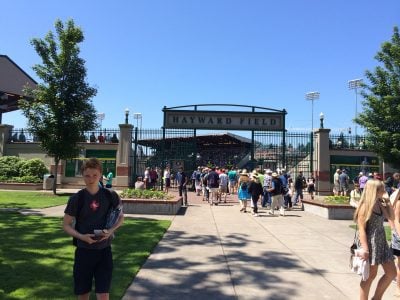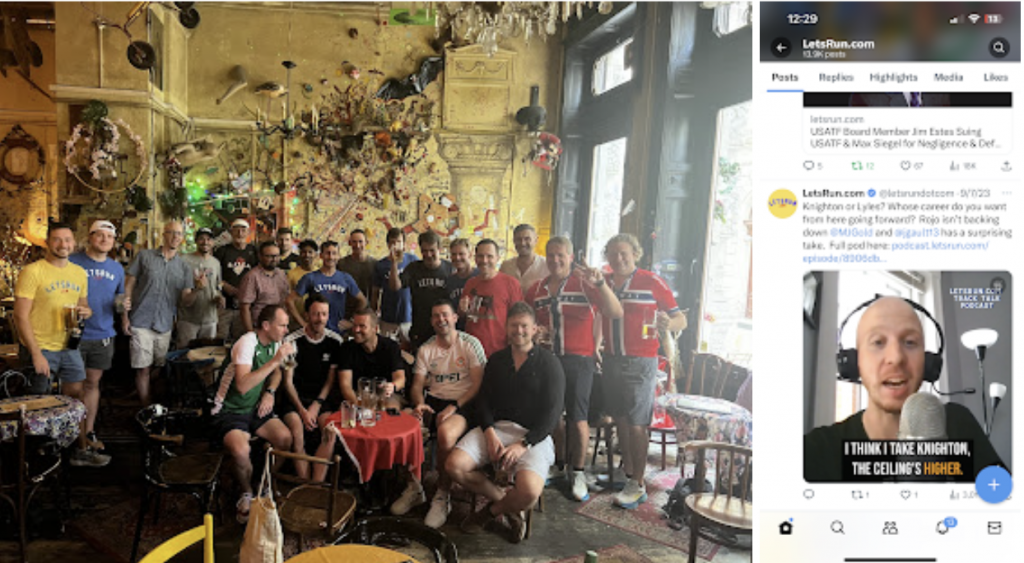2014 Pre Classic Revisited: Lessons from My First Pro Track Meet, 10 Years On
By Jonathan GaultOne of the things I wondered, when I decided to pursue sports journalism as a career, was what would happen if I ever lost the passion. I had been a sports nut all my life, but still I wondered if I would reach a point where, after thousands of games, they would all just blend together and I would stop caring. For the first two decades of my life, following sports had been a hobby (albeit one to which I dedicated an inordinate amount of my free time). Would anything change when it became my sole professional focus?
Well, I’m pleased to report that so far, the answer is no. This week marks the 10-year anniversary of the first meet I covered in person for LetsRun.com, the 2014 Prefontaine Classic. And I am just as excited to fly to Eugene to watch Jakob Ingebrigtsen race Josh Kerr and Yared Nuguse in the Bowerman Mile on Saturday as I was to watch Galen Rupp and David Rudisha in 2014. The fire still burns brightly.
The last 10 years have taken me all over the globe covering this crazy sport, from Eliud Kipchoge‘s training camp in Kenya to the roof of a museum in Denmark, from an auto racing track in the Australian backwater to an empty Olympic stadium in Tokyo. Every day, I consider myself incredibly fortunate to do what I do for a living.
I’ve also learned a hell of a lot about the sport since I first started out in this job. With that in mind, I figured now was an appropriate time to look back at that first meet and some of the lessons it taught me.
Meeting the boss
My first trip for LetsRun.com was almost to the Bahamas. Robert and Weldon Johnson hired me as a summer intern in May 2014, and they had asked me if I wanted to cover the World Relays, which would be held in Nassau from May 24-25.
Did I want a free trip to the Bahamas? Duh!
Unfortunately, they decided (probably correctly) that sending a kid with no experience covering track meets to the Bahamas was perhaps not the best idea, and Weldon went in my place. Instead, my first trip would be to the Prefontaine Classic, with Robert accompanying me to show me the ropes.
A jolt of excitement coursed through my body when I opened Robert’s email and saw my US Airways itinerary: Boston to Portland, with a connection in Philadelphia. I had grown up watching the big meets in Eugene every year on TV, but had never been to the state of Oregon, let alone Hayward Field. Now I would get to see it in the flesh.
Robert was meant to be on my flight from Philadelphia, but there had been some sort of issue and I arrived ahead of him to Portland. As I sat there staring at the floor (this was my introduction to the wonderfully iconic Portland Airport carpet), I began worrying what would happen if Robert failed to show up. Where would I stay? How would I get to Eugene? I was 23 years old, fresh out of grad school and had not had to solve many real-life grown-up problems.
I also began thinking about the man I was waiting on. I had been visiting LetsRun.com for a few years, and from reading his columns, I knew Robert as someone who was not afraid to speak his mind, even on uncomfortable topics. But I did not know all that much about Robert Johnson, the person. My job “interview” had largely consisted of us shooting the shit about running for 20 minutes at that year’s Indoor Heps in Hanover, N.H. I had only met Robert briefly on one other occasion in the summer of 2008, when I was touring colleges before my senior year of high school and Robert was coaching at Cornell. My two main takeaways: he spent a lot of time thinking about running, and he loved to talk.
Turns out, I had nothing to worry about. Robert showed up, and as we headed south in the dark down I-5 toward Eugene, he began peppering me with questions. What was it like being teammates with Abbey D’Agostino at Dartmouth? What did I know about the Nike Oregon Project? What questions was I thinking of asking at the meet?
I quickly found out we had a lot in common. We both liked beer, we both liked sports, and our cross country teams had both gotten their butts kicked by Princeton (me as an athlete, Robert as a coach). Some of the topics of discussion were rated PG-13, bordering on R, but that did not bother me. I liked talking to Robert.
After two hours of driving, we took the exit for Eugene. I knew the name of our hotel, and as we rolled down Franklin Boulevard, just before Track Town Pizza, I suddenly spotted the letters UNIVERSITY INN staring at me out of the darkness on a large, diamond-shaped sign. That was when it hit me that I had made it — not just to our hotel, but to the world of professional track & field. I was really here, in TrackTown USA, to cover a big-time meet. I’ve visited Eugene a lot since then, and I still smile every time I see that sign. I hope they never replace it.
The press conference
Stay in any hotel on a meet weekend in Eugene and you are bound to bump into the friends or family of a runner. The man sharing my table at breakfast on Friday at the University Inn was none other than Will Leer‘s father. Then, as Robert and I headed into the Valley River Inn for that afternoon’s press conference, we saw Shannon Rowbury, running in the next day’s 2-mile, about to check in. I did not expect Rowbury, then a two-time Olympian, to have any interest in talking to us, but it turned out she was happy to stop and chat.
I started to realize that professional runners are, for the most part, pretty normal people. Yes, they are exceptionally fast, but outside of meets, most of them live fairly anonymous day-to-day existences, forced to deal with life’s quirks and inconveniences just like the rest of us (though we don’t have to deal with drug testers showing up once a month at 6 a.m. to watch us pee).
Still, this was a difficult concept to square considering who was headlining the press conference: David Rudisha, racing for the first time in a year following a significant knee injury. Two years earlier, I had watched on a laptop in my kitchen as Rudisha decimated the Olympic final in what remains the greatest 800-meter race ever run. This was no mere mortal. This was a track god with a personal best, 1:40.91, that was not of this Earth. And now I was expected to interview him?
After the athletes were introduced, I ambled over to Rudisha, who was quickly enveloped by a scrum of a dozen reporters. My first impression? He was quiet. So quiet that I had to hold my video recorder uncomfortably close to his face to ensure it picked up the audio. It crossed my mind to ask if he could speak louder, but this was the great Rudisha and I was not going to rock the boat in my very first interview.
As I heard Rudisha speak about his comeback, and the difficulty of watching the 2013 World Championships from the stands in Moscow, I realized I had been wrong. He was mortal. Rudisha was one of the finest runners to ever step foot on a track, but his Olympic gold medal did not make him immune from problems. Lesson one: don’t forget that all athletes, even the great ones, are human beings too.
My second lesson quickly followed. I was interviewing Allyson Felix, asking why she had not run the World Relays, when she mentioned she was coming off an injury. My mind raced. Injury? Then it hit me: Felix had torn her hamstring in the previous year’s World Championship 200-meter final. It had been one of the biggest stories of Worlds, and I felt stupid for not asking her about it. Lesson two: do your homework before an interview.
A few other lessons from that day:
- Shoe sponsors are a big deal. I hate to break it to all those sports marketing execs, but until I started covering the sport professionally, I did not know or care which brands sponsored which athletes. I watched the US and World Championships every year, and while it did not escape my notice that a large number of athletes were sponsored by Nike, I couldn’t have told you who was Nike versus who was adidas or Brooks. I soon learned on the circuit that an athlete’s shoe sponsor could have all sorts of implications, from what meets they appeared at to who was allowed to coach them, and I began committing those sponsors to memory.
- Don’t assume someone is not important just because you’ve never heard of them. In order to cover this sport properly, just knowing the athletes is not enough. There are coaches, agents, meet directors, administrators, communications officers, and a bunch of other people behind the scenes, each of whom has a role to play in making the sport function (thankfully, I had Robert with me to make a bunch of introductions at Pre). During my first two years on the beat, I lost track of how many times I’d see a headline about some seemingly-random person only to read the article and learn about their importance to the sport.
My general approach to life has been to treat everyone I meet with respect, not because they could become a potential source but because it just the decent thing to do. But covering the sport also quickly taught me to be careful about making assumptions, especially when it comes to people. Ted Lasso had it right: be curious, not judgmental.
The 2014 Prefontaine Classic
As I made my way down Agate Street and entered Hayward Field on Saturday afternoon, it felt weird to see track being treated as a big-time sport: sold-out stands and even a scalper or two outside the stadium. The climb up to press row in the old West Grandstand was long but worth it: I never tired of the view of the Douglas firs and hills east of campus as I looked out across the track (sadly, this view is now obstructed at the new Hayward Field). I also learned an architectural lesson: the East Granstand, built in 1925, was actually the famous one. I had always assumed the West Grandstand, with its distinctive flat roof, was more important because it was featured more often during TV broadcasts.
The meet itself was tremendous. Six men broke 3:50 in the Bowerman Mile — and here’s where I start to sound like an old man — which was a big deal back in my day! Actually, that was still the record for most sub-3:50s in one race until last year’s Bowerman Mile blew it out of the water with 11. The late Tori Bowie announced herself as a star, taking down Felix and Shelly-Ann Fraser-Pryce with a shock win from lane 1 in the women’s 200 meters. Rudisha, struggling to adapt to his post-injury body, was so obsessed with holding onto the lead that he spent all his energy battling Mo Aman on the final turn and completely ran out of gas, fading to 7th — the lowest 800-meter finish of his entire career.
Most of the stars from that day have since faded, but some are still around 10 years later. Matthew Centrowitz, who was 8th in the 2014 Bowerman Mile in 3:50.53, will run the Bowerman again this Saturday and will be looking for a similar time (the 2024 Olympic standard is 3:50.40). The women’s 1500 was won by someone named Hellen Obiri, whom I believe is still a pretty good runner. Those 1500 results are fun to look back on now, with a 20-year-old Faith Kipyegon finishing 3rd (yes, there was a time when Faith Kipyegon lost 1500s) and a 21-year-old Sifan Hassan finishing 5th and breaking 4:00 for the first time in her career.
My final journalistic lessons of the weekend had come the night before, however. After Nike’s initial attempt to get Galen Rupp the American 10,000-meter record record had backfired four years earlier, they were running it back at 2014 Pre, bringing in one of the world’s top road runners, Stephen Sambu, to rabbit for the first eight kilometers. Sambu did brilliantly and Rupp closed in a quick 1:57 for his final 800 meters to run 26:44.36 and take more than three seconds off the record.
I had hustled down to the media area to make sure I didn’t miss Rupp, but there had been no need to rush — the general rule is that the better the performance, the longer an athlete takes to come through the mixed zone, and we ended up waiting on Rupp for quite some time.
When he did come through, Rupp took questions for a while, and I noticed that Robert, standing toward the back of the group of reporters, did not ask any. I was surprised. We had flown all the way to Oregon for this meet and Robert was not even going to ask one question to America’s most famous distance runner?
Eventually Rupp’s agent Ricky Simms asked if anyone wanted to ask a final question. Robert sprung into action, asking Rupp if he had seen a recent Deadspin article in which former Oregon Project strength and conditioning coach Vern Gambetta had discussed his time at Nike and the gray area in which some of its athletes operated. It was a dour note on which to end a night that had been a celebration of Rupp, but I also felt it was an important question — the article had been published just one day earlier, and Rupp was one of the NOP’s most prominent athletes.
Simms must have thought it was important as well — before Robert had even finished asking the question, he told Rupp, “You haven’t seen it, you haven’t seen it.”
Now that was the Robert Johnson I had read about. I was glad to be working for someone who was not afraid to ask the hard questions. I still am.
Talk about Jonathan Gault’s 10th anniversary here: MB: We celebrate Jonathan Gault’s 10 years at LetsRun.com!!








